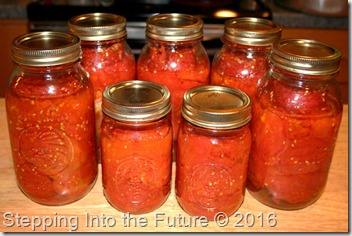Preserving the Harvest
12October 9, 2016 by Jean
 For as long as I can remember, I have loved to eat. There is an old family story about the time I dislocated my shoulder as a toddler; my parents decided I was seriously injured and should be taken to the emergency room when I wouldn’t stop crying to eat my favorite food! Throughout my childhood, I was an enthusiastic eater who never had to be called to the dinner table twice (although I was decidedly unenthusiastic about some foods – especially peas, liver, and orange juice). In adulthood, I developed a love for fresh, whole foods simply prepared.
For as long as I can remember, I have loved to eat. There is an old family story about the time I dislocated my shoulder as a toddler; my parents decided I was seriously injured and should be taken to the emergency room when I wouldn’t stop crying to eat my favorite food! Throughout my childhood, I was an enthusiastic eater who never had to be called to the dinner table twice (although I was decidedly unenthusiastic about some foods – especially peas, liver, and orange juice). In adulthood, I developed a love for fresh, whole foods simply prepared.
Around 2008, reading three books – Michael Pollan’s The Omnivore’s Dilemma and In Defense of Food and Barbara Kingsolver’s, Animal, Vegetable, Miracle – got me enthused about eating local foods, and I became what is called a “locavore,” a person who plans meals around what is available locally. I joined a farm CSA (Community Supported Agriculture plan) where I could get freshly harvested food each week directly from the farm, and I bought as much of my food as possible from farmers’ markets and farm stands, using grocery stores mostly as a supplement to my local food shopping. I am not by any means a strict locavore; three staples of my diet – tea, chocolate, and peanut butter – are definitely not grown in New England! I also buy non-local condiments and spices and an occasional ingredient that is not in season locally (e.g., the avocado garnish for this week’s burritos). For the most part, though, I try to buy local foods that are in season.
Eating local produce year round can be tricky in a place where there is usually snow on the ground from November to April. Fortunately for me, quite a few Maine farmers have adopted the four-season growing practices made popular by Eliot Coleman; this means that some local foods, like salad greens and carrots are now being harvested here through the winter. Other foods – for example, apples, potatoes, pumpkins and winter squash – keep for quite a long time after harvest and are available through most of the winter. With many foods, however, the trick to eating locally is to buy them in bulk when they are harvested and preserve them for eating during the winter and spring.
So at this time of year, I spend quite a bit of time preserving the harvest. In August, I bought a thirty-pound box of Maine wild blueberries, cleaned them, and repackaged them in quart bags (about 21 quarts) for the freezer. I have also frozen several batches of pesto made from fresh local basil, and I have quart bags of sliced red and green peppers in the freezer for winter recipes. One of my big projects each fall is canning tomatoes. Last weekend, I finally got around to purchasing a 25-pound box of canning tomatoes, cleaning them, peeling them, cutting them up, and processing them in a boiling water canner. This is a time-consuming process, but I love having the intense flavor of vine-ripened local tomatoes for use in winter recipes. (And, since I’m canning them myself, I can leave out all the salt that comes in commercially canned tomatoes.)
As fall progresses and turns into winter, I’ll add more items to my winter stockpile, including pumpkins and winter squashes that I roast and puree and freeze for use in various recipes, especially soups and desserts (pumpkin pie, anyone?). After I make my annual roast turkey feast (usually for Christmas), I’ll freeze enough gallons of turkey stock and pounds of turkey meat to last until next year’s turkey.
I count myself lucky to live in a rural state with a vibrant small-farm economy and a significant population of locavore foodies to support that economy. Bon appetit!


Your photo of canned tomatoes brings back warm memories of when I used to help my mother can them…well into my late 30s. She made the best chili sauce, too, and would give my husband 12 jars every Christmas which he genuinely treasured and missed after she died. I used to make mint jelly every fall and this year was going to do it again…until I realized the summer of 2015 when I thought I would move I sold all my canning supplies.
I admire that you buy local as much as possible. I’m sure the food is healthier. My local grocery store—which is actually a four state chain—buys as much Michigan made, grown, baked and canned products and produce as they can and marks them on the shelves so they are easy to find. I really appreciate them doing that and I think they do it in their out-of-states stores, too, with their state products. Support local is important.
Jean, My mother also did a lot of canning, and I have very fond memories of a class-fronted cabinet in the basement full of jars of canned vegetables and jellies. When it was time to open a new jar of jelly, I was always happy to be chosen to go downstairs and pick one out. I didn’t start canning until I was in my fifties, when I attended a local extension office class on canning tomatoes and peaches. As I remember, the fee for the course was $2, and we all got 2 quarts each of tomatoes and peaches and free quart canning jars! A number of states, including Maine, have Master Food Preserver programs (like the Master Gardener programs), designed to teach and promote preserving the local harvest.
Love your picture of the canned tomatoes that you put up. I used to do all of that when my children were small and my full time job was raising them. We had an enormous garden (in Wrentham, MA) where I grew many things. I would grate enough fresh zucchini to make 40 breads and freeze them for the year (and gift-giving). I canned tomatoes. We had a crab apple tree in the back yard and each year I would go back there and spend an entire day picking those little critters. The the next day I would make the crab apple jelly. So clear and pink and pretty and tasty they were. Now, continuing to work full time at a rather strenuous job, I have not the time nor energy to do what you are doing now, but I do admire it so. Perhaps, one day, I shall return to the days of “putting up.”
Sue, I’d like to do more “putting up” now that I have the time. I’m thinking of getting a food dehydrator so that I can make some dried fruit and “sun”-dried tomatoes.
I really do miss the farm I had in Tennessee were I raised cows,pigs,chickens and had a large garden that would feed the neighborhood . I truly enjoyed harvesting and canning with friends and family.
Joyce, I feel like I get the best of both worlds by belonging to a CSA and buying from local farmers. I get the benefits of farm-fresh without having to do all the labor by myself (which I don’t think I could manage).
Doesn’t it make you feel rich to put up all that food? There is a primal satisfaction to it. Maine has such abundant sources or good local food that we eat like royalty here.
Brenda, “Primal satisfaction” is the perfect description of that feeling of safety and security that comes from putting up local food. We are indeed very lucky to live in such a rich agricultural culture.
In the region of the Canadian prairies where I am currently living, there seems to be little interest in or market for local and organic produce. This is in spite of agriculture being the primary industry; however it is all focused on grain, canola, corn, potatoes, ranching, and feedlots. We do have a Saturday morning farmers’ market from May to October, but other than that, locally raised food and especially organic produce is hard to access.
Before moved here, I had a greenhouse, big vegetable garden, and fruit trees. I used to raise a good percentage of our produce, and like you, I preserved it for the winter. My current yard has little space for a food garden, and my heavy workload has left little time for gardening and preserving. When I retire, I hope to do more food gardening again, and be more mindful about purchasing local foods.
Jude
Jude, I experienced something like this when I lived in a fruit-growing region of Pennsylvania. The focus was on growing for export rather than on growing for the local market. Eventually, I managed to find local farms and farm products, mostly through the localharvest.org website.
Because the climate and topography of Maine do not lend themselves to ‘big agriculture,’ the emphasis is on small, family farms. It’s like living in a bygone era.
Sounds delicious!
It is! 🙂